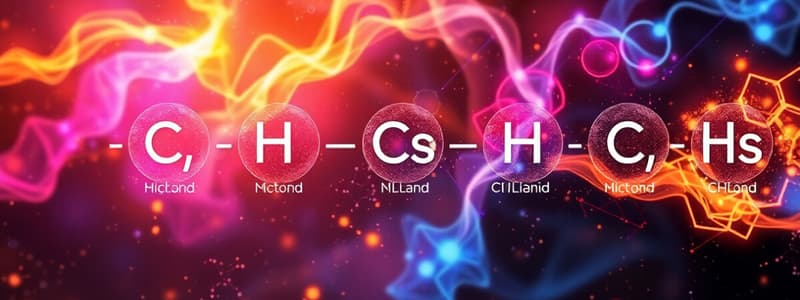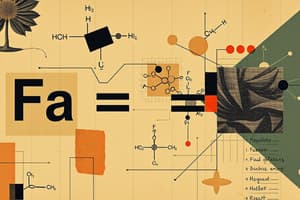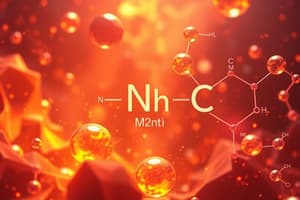Podcast
Questions and Answers
What is the correct name for the ionic compound NaCl?
What is the correct name for the ionic compound NaCl?
- Sodium chloride (correct)
- Sodium oxide
- Sodium fluoride
- Sodium bromide
The criss-cross method is applicable to all types of compounds.
The criss-cross method is applicable to all types of compounds.
False (B)
Name the anion in the ionic compound MgO.
Name the anion in the ionic compound MgO.
Oxide
The formula for potassium bromide is __________.
The formula for potassium bromide is __________.
Match the following elements with their ionic charges:
Match the following elements with their ionic charges:
What does the Stock system identify?
What does the Stock system identify?
Silver forms only one type of cation.
Silver forms only one type of cation.
What suffix indicates a higher charge in the classical system?
What suffix indicates a higher charge in the classical system?
The anion derived from sulfur is called __________.
The anion derived from sulfur is called __________.
Flashcards
Ionic Compound
Ionic Compound
A compound composed of positively charged ions (cations) and negatively charged ions (anions).
Binary Ionic Compound
Binary Ionic Compound
An ionic compound made up of two different elements — one cation and one anion.
Naming Cations
Naming Cations
Use the element's name directly.
Naming Anions
Naming Anions
Signup and view all the flashcards
Criss-Cross Method
Criss-Cross Method
Signup and view all the flashcards
Stock System
Stock System
Signup and view all the flashcards
Classical System
Classical System
Signup and view all the flashcards
Transition Metals
Transition Metals
Signup and view all the flashcards
Study Notes
Ionic Compound Naming and Formulas
- Ionic compounds are composed of cations (positive ions) and anions (negative ions).
- Binary ionic compounds contain two elements. Examples include NaCl (sodium chloride), KBr (potassium bromide), and ZnS (zinc sulfide).
Steps for Naming Ionic Compounds
- Identify the cation and anion.
- Name the cation using the element name (e.g., sodium).
- Name the anion by changing the ending to "-ide" (e.g., fluorine becomes fluoride).
- Write the cation first, then the anion.
Criss-Cross Method
- Used to determine the formula of an ionic compound.
- The charge of one element becomes the subscript (number of atoms) of the other.
Transition Metals and Variable Charges
- Many transition metals (and some Group 4A metals) can form different positive ions with varying charges.
- Representative elements have fixed charges.
Charges of Some Transition and Group 4A Metals
- Transition Metals: Cr2+, Cr3+, Fe2+, Fe3+, Cu+, Cu2+, Ag+, Au+, Au3+, Zn2+, Cd2+
- Group 4A Metals: Sn2+, Sn4+, Pb2+, Pb4+
Stock System
- Used for metals with multiple possible charges.
- The charge of the metal is indicated by a Roman numeral in parentheses after the metal's name (e.g., Chromium(II), Chromium(III)).
Classical System
- Used for metals with multiple possible charges.
- Uses Latin names and suffixes "-ic" (higher charge) and "-ous" (lower charge) (e.g., Fe3+ is ferric, Fe2+ is ferrous).
Studying That Suits You
Use AI to generate personalized quizzes and flashcards to suit your learning preferences.




